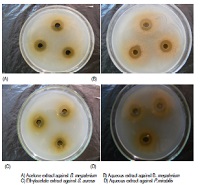Phytochemical, Antimicrobial and Antioxidant properties of an invasive weed - Chromolaena odorata (L.) King & Robinson
Keywords:
Chromolaena odorata, antioxidant, antibacterial activity, phytochemicals, invasive weedAbstract
Chromolaena odorata (L.) King & Rob. native to Tropical America belongs to Asteraceae family, is an invasive weed to Indian context. It spreads all across and started engulfing the forest fringes in Andhra Pradesh and other several states in India. With a view to positive utilization of the invasive weeds, the present work was initiated to study the phytochemical screening, antibacterial and antioxidant, activities of ethyl acetate, acetone, methanol and aqueous extracts of Chromolaena odorata leaves. Phoytochemicals like Saponins, Alkaloids, Flavonoids, Steroids and Tannins were present in the ethyl acetate and aqueous extracts where as acetone and methanol extracts were positive for Flavonoids and Alkaloids. The ethyl acetate and aqueous extracts showed relatively more antibacterial activity than positive control streptomycin by exhibiting larger zone of diameter against Proteus mirabilis MTCC-425, Bacillus megaterium MTCC-428 and Bacillus subtilis MTCC-441. Ethyl acetate (58.34%) and aqueous (56.8%) extracts exhibited more antioxidant activity than the standard ascorbic acid (50.67%). The results revealed that the leaf extracts of Chromolaena odorata contains bioactive compounds having antimicrobial activity and so useful in human medicine.
References
World Health Organization - WHO. General guidelines for methodologies on research
and evaluation of traditional medicine. 2000; HO/EDM/TRM/2000.1 Geneva: p. 74.
Mohanasundari C, Natarajan D, Srinivasan K, Umamaheswari S Ramachandran A.
Antibacterial properties of Passiflora foetida L. – a common exotic medicinal plant.
African Journal of Biotechnology 2007; 6: 2650-2653.
Anyasor GN, Aina DA, Olushola M, Aniyikaye AF. Phytochemical constituent,
proximate analysis, antioxidant, antibacterial and wound healing properties of leaf
extracts of Chromolaena odorata. Annals of Biological Research; 2011; 441-451.
Afolabi C, Akinmoladun, Ibukun EO, Dan-Ologe IA. Phytochemical constituents and
antioxidant properties of extracts from the leaves of Chromolaena odorata . Academic
Journals 2007; 2: 191-194.
Lalith Gunasekera. Invasive Plants: A guide to the identification of the most invasive
plants of Sri Lanka. Colombo 2009; 116–117.
Larguita P. Reotutor, Ed.D , Gemma Agnes R.Supnet. Phytochemical screening of
Wellawel (Chromolaena odorata) leaves, its antimicrobial and coagulative properties.
JPAOR 2008; 1: 111-122.
Warea O. Chromolaena (Siam) weed. Pest Advisory Leaflet no. 43, Secretariat of the
Pacific Community. August, 2004.
Suksamrarn A, Chotipong A, Suavansri T, Boongird S, Timsuksai P, Vimuttipong S, Chuaynugul A. Antimycobacterial activity and cytotoxicity of flavonoids from the
flowers of Chromolaena odorata. Arch Pharm Res 2004; 5: 507-511.
Ling SK, Mazura MD, Salbiah M. Platelet-Activating Factor (PAF) Receptor Binding
Antagonist Activity of the Methanol Extracts and Isolated Flavonoids from
Chromolaena odorata(L.) King and Robinson. Biol. Pharm. Bull. 2007; 30: 1150—
Vaisakh MN, Anima Pandey. The invasive weed with healing properties: a review
on chromolaena odorata. International journal of Pharmaceutical sciences and research
: 80-83.
Ayyanar M, Ignacimuthu S. Herbal medicines for wound healing among tribal people
in Southern India: Ethnobotanical and Scientific evidences. International Journal of
Applied Research in Natural Products 2009; 2: 29-42.
Evans WC. Trease and Evan's Textbook of Pharmacognosy,1989; p. 546, 13 th Ed.
Cambridge University Press, London.
Utpal Kumar Karmakar, Soma Pramanik, Samir Kumar Sadhu, Manik Chandra
Shill, Subrata Kumar Biswas. Assessment of analgesic and antibacterial activity
of Premna Integrifolia linn. (family: verbenaceae) leaves. International journal of
Pharmaceutical sciences and research 2011; 2: 1430- 1435.
Naga babu, P, UmamaheswaraRao,V. Antibacterial activity and phytochemical
screening of leaves and stem extracts of Avicennia Alba Blume. International journal
of applied biology and Pharmaceutical technology 2000; 3: 399-405.
Ai Lan Chew, Jeyanthi James Antony Jessica, Sreenivasan Sasidharan.
Antioxidant and antibacterial activity of different parts of Leucas aspera Asian
Pacific Journal of Tropical Biomedicine 2012; 2(3):176-180.
Tapas AR, Sakarkar DM, Kakde RB. Flavonoids as Nutraceuticals: A Review.
Tropical Journal of Pharmaceutical Research 2008; 7 : 1089-1099.
Qureshi NN, Bhanudansh SK, Nadeem AL, Majid AH. Antioxidant and
hepatoprotective activity of Cordia macleodii leaves. Saudi Pharmaceutical Journal
; 17: 299–302.
Rice-Evans C. Flavonoids and Isoflavones: absorption, metabolism and bioactivity.
Free Rad.Biol 2004; 36: 827-828.
Vinayagam A, Sudha PN. Antioxidant activity of methanolic extracts of leaves and
flowers of Nerium indicum. International journal of pharmaceutical sciences and
research 2011; 2: 1548-1553.
Mathew, S. and T.E. Abraham, 2006. Studies on the antioxidant activities of
cinnamon (Cinnamomum verum) bark extracts, through various in vitro models. Food
Chem., 2006; 94: 520-528.
Salau, AO, Odeleye OM. Antimicrobial activity of Mucuna pruriens on selected
bacteria. African Journal of Biotechnology 2007; 6 : 2091-2092.
Girish HV, Satish S. Antibacterial Activity of Important Medicinal Plants on Human
Pathogenic Bacteria-a Comparative Analysis. World Applied Sciences Journal 2008;
: 267-271.
Muñoz-Mingarro NAD, Llinares F, Pozuelo JM, Galán de Mera A, Vicenten
JA, Morales L, Alguacil LF, Pérez C. Biological activity of extracts from Catalpa
bignonioides Walt. (Bignoniaceae). Journal of Ethnopharmacology 2003; 87: 163–
Coelho de Souza, G, Haas APS, Von Poser G.L, Schapoval EES, Elisabetsky E.
Ethnopharmacological studies of antimicrobial remedies in the south of Brazil. J.
Ethnopharmacol., 2004; 90: 135-43.



